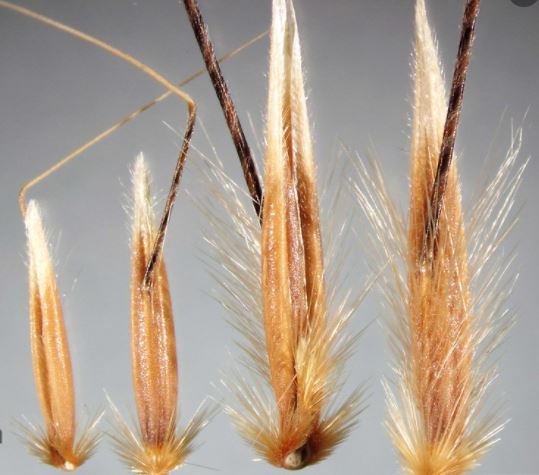It is easy enough to recognise that an Oat belongs to the genus Avena, but the key to the species is quite challenging, despite there being only 5 species to consider. 

Avena are all annuals, with spikelets of 2-3 florets. The lemmas are bifid or have 2 bristles at the apex, and they may or may not have a long, bent dorsal awn. There is very great plasticity in the size of the parts of the flower, and you need fruits that are fully ripe for ID. 

We'll begin with the 2 species that have long (3-9mm (left) not short 0.5-2mm (right)) apical points to the lemma. The question is very tricky for beginners: "Rachilla disarticulating between the florests at maturity" or not so. 



Thousands of years of selection on crop plants have resulted in the fruits not falling until after the crop has been harvested. Wild plants often have fruits that fall one at a time as they ripen. This falling-off is called "disarticulation" (early breaking-up of the rhachilla) 

The difficulty is that before any of the florets have fallen, you can't be sure whether any of them are destined to fall off early. The old 'absence of evidence' problem again. You need to break off a floret (forcibly). Is there are smooth scar (left) or a jagged one (right) 

The other question is easier: are there dense long hairs on the lower half of the lemma (left) or not (right). So hairy and disarticulating is Avena brabata, and not disarticulating and glabrous to sparsely hairy is A. strigosa. 



Now for the 3 species that have short apical points to the lemma. First, the crop plant Avena sativa. This has been selcted so as not to disarticulate, so that when you pull off a floret it leaves a jagged tear (not a smooth scar). The lemma is usually unawned (selection again) 

The last two species have at least 1 smooth disarticulation scar. Avena sterilis (left) has bigger glumes (25-30mm) than A. fatua (18-25mm, right). The latter has smooth scars for all florets, the former only above the glumes (i.e. there are 2-3 fruits per dispersal unit, left) 



To summarise, our crop Oat (Avena sativa) typically has no awns. The 2 common crop weeds (Wild Oats) have long awns. In winter crops you are most likely to see A. sterilis (A. ludoviciana as was, left) and spring-sown, A. fatua (right) 



• • •
Missing some Tweet in this thread? You can try to
force a refresh



























